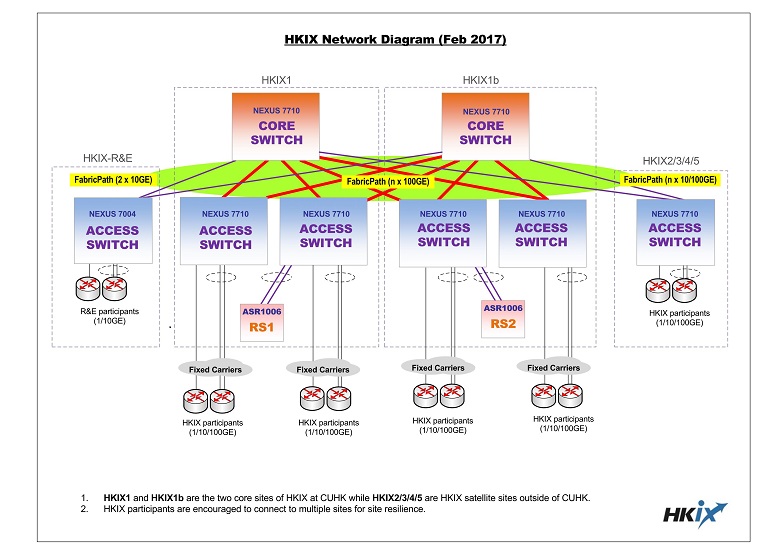
After more than two years of negotiations, the Hong Kong Internet eXchange (HKIX) will launch three new satellite sites by the end of April 2017.
These new sites will improve HKIX’s geographical coverage and redundancy measures on its backbone, and allow existing and potential HKIX participants to connect to HKIX faster, more easily and more cheaply.
Below is the list of the three new satellite sites and the relevant collaborators, all of whom are commercial data centres:
- HKIX3 site: SUNeVision/iAdvantage @Fo Tan
- HKIX4 site: NTT Com Asia @TKO
- HKIX5 site: KDDI/Telehouse/HKCOLO.NET @TKO
These new sites will complement the existing HKIX1 and HKIX1b sites at the Chinese University of Hong Kong (CUHK) and the HKIX2 site at CITIC Telecom International, Kwai Chung – the latter has also been converted to the new satellite site model.
Connecting to one of these satellite sites will be the same as connecting to any other site of HKIX because it is the same layer-2 network.
The addition of these new sites will help HKIX maintain its growth and help Hong Kong solidify its position as one of the major Internet hubs in the Asia Pacific.
They will also help Hong Kong to establish its new position as one of the major data centre hubs in the region because it can attract more networks from overseas to come to Hong Kong by co-locating their servers and equipment at those satellites sites.
New sites set to sustain HKIX for a further 22 years
The launch of these new sites is a testament to the experience and longevity of HKIX, which will celebrate its 22nd anniversary this year.
HKIX is one of the earliest layer-2 Internet exchange points (IXPs) set up in the Asia Pacific, before almost all incumbent carriers established their own ISP businesses. Owing to its long history, neutrality and not-for-profit status, HKIX has been able to gain critical mass, attracting not only networks in Hong Kong but also networks from all over Asia. This makes it an IXP for the whole region.
HKIX was established by the Information Technology Services Centre (ITSC) at the CUHK in April 1995. Since then, its core equipment has been located in the central data centre of CUHK.
In the early days, when a network wanted to connect to HKIX, it needed to lease a local loop and put a router at the HKIX core site, which would consume data centre space and power. Later, there were options of ATM local loops and then Ethernet local loops that eliminated the need of having co-located routers at the HKIX core site.
But when the IXP became more and more important, HKIX saw the need of having a backup site. That’s why the HKIX2 site was established in a data centre run by a carrier in 2004 to increase resilience – the original HKIX core site was named HKIX1 afterwards. However, as the HKIX2 site was not considered neutral enough by the industry, it was not selected by many HKIX participants for backup connections to HKIX.
In 2014, to leverage the establishment of a new central data centre at CUHK, together with the one-off funding support by the Hong Kong SAR Government, another core site of HKIX (named HKIX1b site) was established with new equipment and network architecture, and with very high scalability. It enabled HKIX to improve its redundancy and set in motion a strategy to establish multiple satellite sites at numerous commercial data centres outside of the CUHK campus.
HKIX needs to be self-sustaining in the long-term for it to continue to serve the community. That is why in 2013, it adopted a simple port charge model, similar to what other IXPs are doing around the world. Now, HKIX is cash-flow positive with no donations from outside and no subsidies from CUHK, which is demanded by the main funding agency of CUHK.
Moving forward, HKIX needs to find a solid operating model to sustain itself in the long-term, such as adding more satellite sites from time to time. It is also focused on managing and improving critical Internet infrastructure (such as authoritative DNS server instances of root and Top Level Domains) and research and education networks with its limited co-location facilities.
The governance board of HKIX is looking forward to continually improving the service for its participants and appreciates the continuous support from the community.
Che-Hoo Cheng is in charge of HKIX operations at The Chinese University of Hong Kong.
The views expressed by the authors of this blog are their own and do not necessarily reflect the views of APNIC. Please note a Code of Conduct applies to this blog.


Happy to here this!! Keep it up!